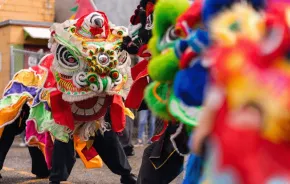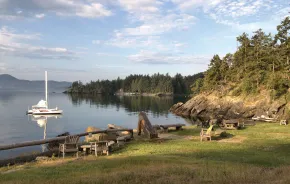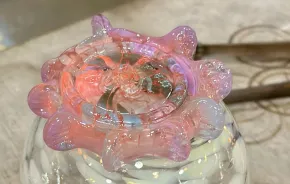 Before my son spoke in complete sentences, he could identify granite from diorite in my old college geology textbook. That’s when I knew it was true: Kids really dig rocks.
Before my son spoke in complete sentences, he could identify granite from diorite in my old college geology textbook. That’s when I knew it was true: Kids really dig rocks.
Young children seem to have an innate curiosity about nature. It’s up to us as parents to open up the natural world to that curiosity. And so I thought, what better way to blossom my child’s interest in rocks than a trip to a local geologic wonder?
After all, we live in one of the most geologically active regions on earth. Just glance at a map and you’ll see that many of our Northwest iconic landmarks are real-life evidence of our geologic past (and future), from the volcanic Cascade Mountain Range to offshore sea stacks of basalt formed by centuries of pounding waves.
These geology-inspired vacations are scenic and fun, but they also offer something more — a chance for curious kids to get a hands-on, up-close education in geologic events that formed the landscapes in their Northwest backyard.
 Mount St. Helens National Volcanic Monument
Mount St. Helens National Volcanic Monument
Skamania County
Info: fs.usda.gov/mountsthelens
Thirty-three years after an eruption spewed 540 million tons of ash into the air and around the globe, Mount St. Helens is a living laboratory where you can observe the forces of geologic nature in real time. The monument offers three different approaches to the volcano — from the west, east and south sides.
The approach from the west is via State Route 504, which ends at the Johnston Ridge Observatory and an overlook with a view directly into the volcano’s gaping crater. Let interpretive kiosks guide you through the eruption along the paved, half-mile trail, which starts from the observatory, with 360-degree views of Mount St. Helens and the surrounding blast zone. Inside the observatory (open 10 a.m.–6 p.m. daily from mid-May through October) are interactive displays, films and ranger talks through which kids can learn all about the geological story of the eruption. (Entrance fee is $8/adult, children 15 and younger are free.)
On the volcano’s south side (via Highway 503), you can hike right into the underground world of a real lava tube at Ape Cave, a natural tunnel below the earth’s surface through which lava travels (or in this case, used to travel) during an eruption. The path is rough in places, and reliable flashlights and lanterns are required. Dress in layers as the lava tube is 42 degrees year-round. A Northwest Forest Pass is required to park here.
If you go: You won’t find a campground in Mount St. Helens National Volcanic Monument, but there are a few in the surrounding Gifford Pinchot National Forest. Iron Creek, south of Randle on the Cispus River, accepts advanced reservations, or rent one of the five yurts at Seaquest State Park (it has campsites, too). If you find yourself on S.R. 504, stop by Patty’s Place @ 19 Mile House for its famous fruit cobblers and elk burgers.
 Oregon Caves National Monument
Oregon Caves National Monument
Southwest Oregon
Info: nps.gov/orca
Nestled deep in the Siskiyou Mountains of southwest Oregon are the “marble halls” that comprise Oregon Caves National Monument, a dripping labyrinth of stalactites, moon milk and cave pearls. Your kids will see all these cool cave features up close while on a professionally guided tour into the sprawling cavern, which includes more than 15,000 feet of passageway. These “solution caves” formed when rainwater from the ancient forest above percolated through the ground into the bedrock below, in this case, a deep layer of marble. The natural acids in the water dissolved the marble, one drop at a time.
Touring the main cave is a moderately strenuous 90-minute activity, as there are a few hundred steps to climb and you need to hunch under and squeeze around marble formations in tight places. Children must be taller than 42 inches in height to take the tour. Wear sturdy shoes and dress warmly, as it’s a cool 43 degrees in the caves.
Costs: There’s no entrance fee to the national monument, but the cave tour costs $8.50 for adults, and $6 for ages 16 and younger.
If you go: This region is a 10-hour drive from Seattle, the bulk of the trip a straight shot down Interstate 5. For the full experience of the monument, reserve a room at the six-story Chateau at the Oregon Caves (open May–September). This Depression-era lodge has all the rustic charms of a Northwest lodge, from the spacious lobby with board games and a fireplace to Craftsman architecture. Kids will love the nostalgic soda fountain café, and parents will love the great lodge restaurant. Room rates are $109–$199, and there are some family suites.
 John Day Fossil Beds National Monument
John Day Fossil Beds National Monument
Eastern Oregon
Info: nps.gov/joda
This eastern Oregon treasure is guaranteed to impress young paleontology buffs. At first glance, you see a stunning landscape with multicolored badlands and eroded pinnacles. Get a little closer and you’ll discover an amazing assortment of fossils in them thar hills. Composed of sedimentary rocks, the fossils preserve a record of 40 million years of plant and animal life.
John Day Fossil Beds National Monument consists of three distinct units of strata (the Clarno Unit, the Painted Hills Unit and the Sheep Rock Unit), with a sizable distance between them. All are worth a visit, so plan to spend two days hiking the short trails at each unit and exploring the greater region.
Start your visit at the Sheep Rock Unit, if possible, where the awesome Thomas Condon Paleontology Center offers interactive exhibits and murals on the geologic history of the region. There’s even a viewing window into the fossil laboratory, where the monument’s paleontologists are hard at work.
The Painted Hills Unit is more famous for its rocks striped with vivid hues of orange, pink, bronze and black than for the fossils embedded in them; the hues deepen as the sun begins to set in the late afternoon or evening.
The oldest fossil beds are at the Clarno Unit. It’s difficult to fathom as you stand here on a relentlessly sunny day (bring wide-brimmed hats), but this land was once covered by a subtropical rainforest; now, only relics of that forest remain, including the impressions of tiny four-toed horses, huge rhino-like brontotheres, leaves, nuts and seeds embedded in the rocks.
Costs: There are no entrance or use fees at John Day Fossil Beds.
If you go: The monument doesn’t allow camping, but there are national forest campgrounds nearby. The best is Bull Prairie Campground, set on the shore of Bull Prairie Lake in the Umatilla National Forest just north of Spray. For a roof over your head, the Oregon Hotel in Mitchell is a homey bed-and-breakfast with all units priced at less than $100 a night for family-sized rooms.
 Olympic National Park Beaches
Olympic National Park Beaches
Northwest Washington Coast
Info: nps.gov/olym/planyourvisit/visiting-kalaloch-and-ruby-beach.htm
The Northwest coast is punctuated with dramatic landforms called sea stacks, which look like tall islands, and make for both stunning scenery and a powerful geologic story. Visit an Olympic National Park beach to get a close look at how the gradual, relentless erosion of pounding waves against a rocky headland results in these fascinating rock outcrops.
An easily accessible beach to explore is Ruby Beach, right off Hwy. 101 southwest of Forks. The trail from the parking lot is an easy .25 mile before it spills you out onto the pinkish beach, tinted from very tiny crystals of garnet in the sand here (hence the beach’s name). My son was perfectly happy to stop and dig in the expanse of pink sand — bring a bucket and shovel along for little diggers.
A shallow creek bisects the beach, and there are two distinct types of rock exposed in the outcrops on either side. To the south, the rocks are primarily sedimentary, part of the Hoh sandstone formation, which is a marine deposit. Keep an eye out for clamshell fossils. To the north of the creek, the rock outcroppings are more volcanic in origin, and the large sea stack off the coast known as Abbey Island is composed mainly of volcanic breccia.
When exploring tide pool areas, consult a tide chart before you go and make sure the kids wear sturdy shoes, because the rocks can be slippery. A geology hand lens is a nice tool to bring along for close inspection of sand, rocks and fossils you may come upon.
If you go: Kalaloch Lodge is perched on a sandstone bluff with steps down to Ruby Beach, where impromptu geology lessons await. Accommodations are lodge rooms and basic bluff cabins with kitchenettes, most with good views of the water below. Kalaloch Lodge’s restaurant has standard Northwest fare, such as clam chowder, fish and chips, and steaks. Just up Hwy. 101 is Kalaloch Campground, set on another spectacular sandstone bluff overlooking the ocean.
Lauren Braden is a travel writer based in Seattle. Read about her family’s adventures and get more local travel tips at Northwest TripFinder.
Four More Rock Hound Trips
Hike in the Ginkgo Petrified Forest State Park, east of Ellensburg, Wash., and discover what happens when a wet tropical forest becomes flooded with lava. (Hint: The trees turn to stone.) A two-mile interpretive trail leaves from the visitor center. Be sure to stop in at the center, where polished petrified specimens can be touched and held.
South of Olympia, explore the Mima Mounds, grassy humps of mysterious origin that look like the work of giant garden moles. Theories of their creation range from seismic activity to wet clay soils. Children can ponder this mystery as they walk the paved interpretive trail through the mounds.
Visit Flaming Geyser State Park near Black Diamond (in the Mount Rainier area), named for a continuous flame that burns through a cement basin fueled by a methane seep. The methane originates in a gas pocket 1,000 feet below the surface.
Rainy day? The Rice Northwest Museum of Rocks and Minerals, in Hillsboro, Ore., boasts a gemstone and mineral collection that dazzles rock hounds of all ages, with specimens ranging from agates and crystals to fossils and even meteorites.











